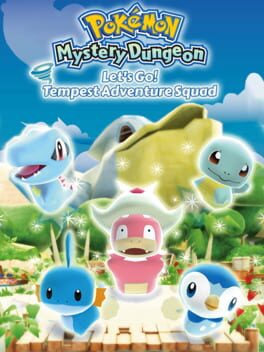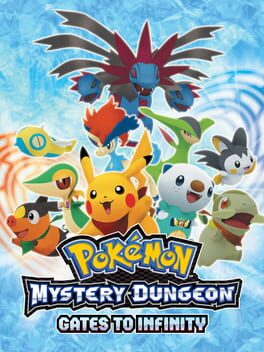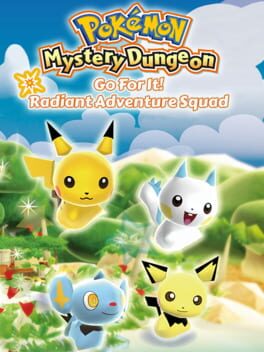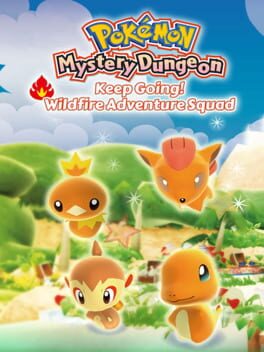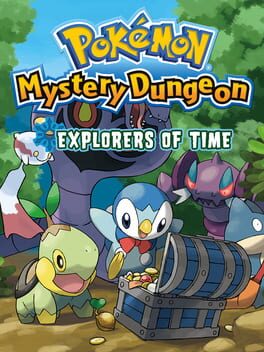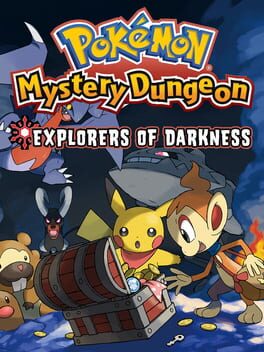

Pokémon Mystery Dungeon: Let's Go! Tempest Adventure Squad
released on Aug 04, 2009
Pokémon Mystery Dungeon: Let's Go! Tempest Adventure Squad is a Role-Playing game, developed by ChunSoft and published by The Pokemon Company, which was released in Japan in 2009.
Also in series
Reviews View More
These are games I bought years and years ago back when it was first announced that the Wii’s eShop would be shutting down. I held on to the Wii that I bought them on (the very same Japanese Wii I bought during my visit way back in 2013), and they’ve just sorta been on my plate, ready to be gotten to whenever I’ve felt the burning urge for more Mystery Dungeon. After playing and enjoying Chocobo Dungeon 2 so much, I felt it was high time I booted one of these up and finally played through it. I wasn’t originally going to play through all of them, but I figured, eh, why not just play through each as long as I had the Wii up and I wasn’t hating my time with them, so I just played through all three. I played through Flame first, and then Storm, and then Light, and it took me a combined 25-ish hours to do it all via the Japanese versions on real hardware.
Like virtually all Pokemon releases, there were three versions of this with almost identical stories. It follows the adventures of a small Pokemon adventure team in either the Pokemon Village, Pokemon Beach, or Pokemon Garden (depending on the version you’re playing), though the layouts of each are exactly the same. Oddly enough, these are basically the only PMD games where you don’t play an actual main character, and you can swap who your team leader is immediately too. Being WiiWare games, these don’t really have the file sizes to have much in the way of long story content, and they don’t push the envelope on that front. They’re short, simple stories that have some fun dialogue, but are ultimately pretty forgettable, especially when compared to their far meatier handheld counterparts and their quite good stories. The stories being weak aren’t exactly a bad thing in a vacuum, but it’s definitely something that’s going to underwhelm and disappoint any big PMD fan who went out of their way to track these down to play them in this day and age, that’s for sure.
The gameplay of each is pretty straightforward Pokemon Mystery Dungeon. You have a team of up to four Pokemon, you go through procedurally generated dungeons to complete rescue requests you pick up on the billboard in town, and you can recruit Pokemon if you’re lucky enough upon recruiting them. There aren’t many dungeon types, but given that it’s all procedurally generated, that’s not a terribly huge deal as long as they have all the Pokemon, and shockingly enough, all 493 Pokemon that existed at the time actually are available to recruit into your team for anyone crazy enough to get all three games and play them that obsessively.
The big gimmick of these games that makes them stand out from the other Mystery Dungeon-type games (though I’ve heard one or two have dabbled in it since) is the Pokemon Tower mechanic. After the third dungeon has been unlocked, you’re taught how to do the Pokemon Tower, which involves finding a hole in a dungeon, and then being able to stack your Pokemon in a tower up to four Pokemon tall. Pokemon towers are VERY strong, as not only do the two to four of them share a combined health bar, but if the Pokemon at the base uses a special move, everyone in the tower can use one too. Not only that, but the Pokemon not at the tower’s base get to use their moves for free, so they don’t actually even consume PP as they’re doing it. Pokemon come in 4 size rankings, and you can only stack a maximum of two Pokemon of the same size on top of one another, so building a team that’s both strong and readily stackable is an important part of any successful Adventure Team. Pokemon towers are extremely powerful, which is why your enemies will do them too, but that’s kinda where the game’s issues begin.
Pokemon towers are SO powerful that not being in one is basically an invitation to die. The start of a dungeon is always the most dangerous part, since if you don’t find a hole to stack in quickly, you’ll be hunted down and killed very fast because the enemy tower’s move chains are exactly as devastating as your own. On top of that, there are hidden traps on the floor of the dungeons that will unstack you, and even weather events at the start of a floor that will ALSO unstack you completely. In a normal Mystery Dungeon game, these sorts of things wouldn’t be so bad, but given just how crucial your tower is to staying alive, you’re relying a LOT on the traps’ RNG to not screw you over at any given time unless you want to grind a LOT.
These games being somewhat content poor also lends to them being pretty bad with the grinding they require to see the credits (and just do new content full-stop, really). The penultimate and especially the ultimate story dungeons are REALLY significant jumps in difficulty from the previous dungeons, and you’ll likely need to be doing a couple hours of grinding to get your team to a place where they actually have a chance to survive to the end. Survive is actually the key word there, oddly enough, as these games actually have no bosses. Likely a factor of their light story content, it’s not a problem per se, but it’s just one more thing that makes them feel like the budget titles that they are.
Lastly, a weird thing these games have for a PMD game that’s actually something they share with Chocobo Dungeon 2 is that your Pokemon can actually evolve anywhere at any time as long as the right requirements. For your own Pokemon, it’s kinda neat that you don’t need to wait until some special post-game area unlocks to be able to evolve your Pokemon, but for your enemies it’s a different story. Just like in Chocobo Dungeon 2, if one of your allies gets taken down, the enemy that did it will evolve immediately to a stronger form. That’s not quite so bad in a well balanced game like Chocobo Dungeon 2, but it’s very often immediately a death sentence in a game like Pokemon where an evolution can theoretically make an enemy jump up in power some 15 or 20 levels in an instant, and there’s virtually nothing you can do about it. It’s not as big an issue overall as the poor level curve or the RNG that dictates the survival of Pokemon towers, but it’s just one more aspect that makes these games feel unfair and frustrating (even for RNG-dictated games like Mystery Dungeon ones).
The aesthetics are overall just fine. They use the character models from the Pokemon Ranch and Pokemon Rumble Arena games, so if you’re a fan of those, you’ll like these, and if you’re not a fan, you’ll not care for them. The areas are bright and colorful, and I thought the game looked quite nice, and it’s honestly always hilarious watching your Pokemon hop on top of each other and make scared little faces as their tower teeters back and forth XD. The music is very solidly OK, but it’s nothing special. The game’s presentation is good-to-serviceable, and I’d have a hard time finding outright faults or strengths in it unless someone has extreme feelings on the Pokemon Ranch art style one way or the other.
Verdict: Hesitantly Recommended. Even as poorly balanced and frustrating as these games often are, I did have fun with them. Even with each new one I started, despite the annoyances of when I wasn’t in a tower, it was hard not to feel a satisfying rush of power once my Pokemon had towered up and I could start raining hellfire down on my enemies once more. There aren’t exactly a wealth of options for console-native Pokemon Mystery Dungeon experiences, and if you REALLY must have one, these are perfectly serviceable for a fun enough time in a Mystery Dungeon game on your Wii. That said, it’s really just damning with faint praise. Any fan big enough to be even considering hunting these and their English patches down to play these days will definitely be familiar with the better made PMD games, and it’s impossible to not be constantly comparing these to their far superior handheld cousins. If you’re a big fan of Mystery Dungeon games and want something a bit quirky and different and don’t mind some poor balancing, then these could certainly be a quite fun time. However, if you’re someone who’s a big PMD fan and you’re hoping that these will be some secret, lost entries as great as the contemporary Explorers Of games, then you’re going to be really disappointed with these, and you’re better off avoiding them.
Like virtually all Pokemon releases, there were three versions of this with almost identical stories. It follows the adventures of a small Pokemon adventure team in either the Pokemon Village, Pokemon Beach, or Pokemon Garden (depending on the version you’re playing), though the layouts of each are exactly the same. Oddly enough, these are basically the only PMD games where you don’t play an actual main character, and you can swap who your team leader is immediately too. Being WiiWare games, these don’t really have the file sizes to have much in the way of long story content, and they don’t push the envelope on that front. They’re short, simple stories that have some fun dialogue, but are ultimately pretty forgettable, especially when compared to their far meatier handheld counterparts and their quite good stories. The stories being weak aren’t exactly a bad thing in a vacuum, but it’s definitely something that’s going to underwhelm and disappoint any big PMD fan who went out of their way to track these down to play them in this day and age, that’s for sure.
The gameplay of each is pretty straightforward Pokemon Mystery Dungeon. You have a team of up to four Pokemon, you go through procedurally generated dungeons to complete rescue requests you pick up on the billboard in town, and you can recruit Pokemon if you’re lucky enough upon recruiting them. There aren’t many dungeon types, but given that it’s all procedurally generated, that’s not a terribly huge deal as long as they have all the Pokemon, and shockingly enough, all 493 Pokemon that existed at the time actually are available to recruit into your team for anyone crazy enough to get all three games and play them that obsessively.
The big gimmick of these games that makes them stand out from the other Mystery Dungeon-type games (though I’ve heard one or two have dabbled in it since) is the Pokemon Tower mechanic. After the third dungeon has been unlocked, you’re taught how to do the Pokemon Tower, which involves finding a hole in a dungeon, and then being able to stack your Pokemon in a tower up to four Pokemon tall. Pokemon towers are VERY strong, as not only do the two to four of them share a combined health bar, but if the Pokemon at the base uses a special move, everyone in the tower can use one too. Not only that, but the Pokemon not at the tower’s base get to use their moves for free, so they don’t actually even consume PP as they’re doing it. Pokemon come in 4 size rankings, and you can only stack a maximum of two Pokemon of the same size on top of one another, so building a team that’s both strong and readily stackable is an important part of any successful Adventure Team. Pokemon towers are extremely powerful, which is why your enemies will do them too, but that’s kinda where the game’s issues begin.
Pokemon towers are SO powerful that not being in one is basically an invitation to die. The start of a dungeon is always the most dangerous part, since if you don’t find a hole to stack in quickly, you’ll be hunted down and killed very fast because the enemy tower’s move chains are exactly as devastating as your own. On top of that, there are hidden traps on the floor of the dungeons that will unstack you, and even weather events at the start of a floor that will ALSO unstack you completely. In a normal Mystery Dungeon game, these sorts of things wouldn’t be so bad, but given just how crucial your tower is to staying alive, you’re relying a LOT on the traps’ RNG to not screw you over at any given time unless you want to grind a LOT.
These games being somewhat content poor also lends to them being pretty bad with the grinding they require to see the credits (and just do new content full-stop, really). The penultimate and especially the ultimate story dungeons are REALLY significant jumps in difficulty from the previous dungeons, and you’ll likely need to be doing a couple hours of grinding to get your team to a place where they actually have a chance to survive to the end. Survive is actually the key word there, oddly enough, as these games actually have no bosses. Likely a factor of their light story content, it’s not a problem per se, but it’s just one more thing that makes them feel like the budget titles that they are.
Lastly, a weird thing these games have for a PMD game that’s actually something they share with Chocobo Dungeon 2 is that your Pokemon can actually evolve anywhere at any time as long as the right requirements. For your own Pokemon, it’s kinda neat that you don’t need to wait until some special post-game area unlocks to be able to evolve your Pokemon, but for your enemies it’s a different story. Just like in Chocobo Dungeon 2, if one of your allies gets taken down, the enemy that did it will evolve immediately to a stronger form. That’s not quite so bad in a well balanced game like Chocobo Dungeon 2, but it’s very often immediately a death sentence in a game like Pokemon where an evolution can theoretically make an enemy jump up in power some 15 or 20 levels in an instant, and there’s virtually nothing you can do about it. It’s not as big an issue overall as the poor level curve or the RNG that dictates the survival of Pokemon towers, but it’s just one more aspect that makes these games feel unfair and frustrating (even for RNG-dictated games like Mystery Dungeon ones).
The aesthetics are overall just fine. They use the character models from the Pokemon Ranch and Pokemon Rumble Arena games, so if you’re a fan of those, you’ll like these, and if you’re not a fan, you’ll not care for them. The areas are bright and colorful, and I thought the game looked quite nice, and it’s honestly always hilarious watching your Pokemon hop on top of each other and make scared little faces as their tower teeters back and forth XD. The music is very solidly OK, but it’s nothing special. The game’s presentation is good-to-serviceable, and I’d have a hard time finding outright faults or strengths in it unless someone has extreme feelings on the Pokemon Ranch art style one way or the other.
Verdict: Hesitantly Recommended. Even as poorly balanced and frustrating as these games often are, I did have fun with them. Even with each new one I started, despite the annoyances of when I wasn’t in a tower, it was hard not to feel a satisfying rush of power once my Pokemon had towered up and I could start raining hellfire down on my enemies once more. There aren’t exactly a wealth of options for console-native Pokemon Mystery Dungeon experiences, and if you REALLY must have one, these are perfectly serviceable for a fun enough time in a Mystery Dungeon game on your Wii. That said, it’s really just damning with faint praise. Any fan big enough to be even considering hunting these and their English patches down to play these days will definitely be familiar with the better made PMD games, and it’s impossible to not be constantly comparing these to their far superior handheld cousins. If you’re a big fan of Mystery Dungeon games and want something a bit quirky and different and don’t mind some poor balancing, then these could certainly be a quite fun time. However, if you’re someone who’s a big PMD fan and you’re hoping that these will be some secret, lost entries as great as the contemporary Explorers Of games, then you’re going to be really disappointed with these, and you’re better off avoiding them.
